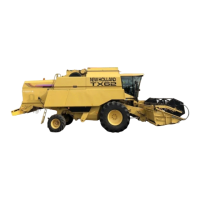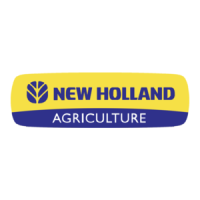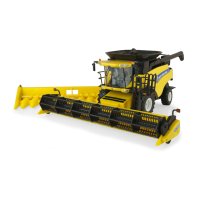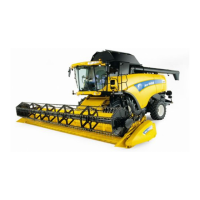Do you have a question about the New Holland TX64 Plus and is the answer not in the manual?
Locate and record serial numbers for the combine, engine, and attachments.
Understand and follow all safety precautions, including CAUTION, WARNING, and DANGER symbols.
Essential safety rules for operating the combine on various terrains and public roads.
Location and meaning of safety decals on the machine for operator awareness.
Description of various control modules, including the instrument panel, arm rest, and steering column.
Overview of the InfoView monitor and general module, including warning lights and indicators.
Pre-operation checks including tyre pressure, fluid levels, belt tensions, and controls.
Step-by-step procedure for safely starting the combine's engine, including daily checks.
Guide to locating grease fittings and understanding lubrication intervals indicated by decals.
Steps for checking oil level, changing oil and filter, and oil specifications for the hydrostatic system.
Comprehensive schedule detailing lubrication items, intervals, amounts, and specifications.
Essential checks before operating the combine, including wheel nuts, fluid levels, and belt tensions.
Information on attaching, detaching, and operating the header unit.
Parameters and fundamentals for adjusting drum speed and concave clearance for optimal threshing.
Methods for adjusting concave clearance manually or electrically based on crop type.
Overview of the InfoView monitor display and its various operating modes for monitoring combine parameters.
Maintenance procedures for the brake system, including parking brake adjustment.
Steps for adjusting the parking brake mechanism for both standard models and TX67.
Maintenance and adjustment procedures for the steering axle assembly.
Procedure for checking and adjusting the toe-in of the steering wheels for proper alignment.
Checking fuel level, filling the tank, and fuel quality importance.
Checking coolant level, coolant change procedure, and system capacity/specifications.
System maintenance procedures for hydraulic hoses and valves.
Overview of the electrical system, including fuses, relays, and modules.
Identification of fuse and relay locations, amperage, and functions for troubleshooting and replacement.
Schedule of service tasks to be performed at various operating hour intervals and time periods.
Common issues related to irregular feeding into the straw elevator and backfeeding problems.
Troubleshooting for grain not properly threshed, material wrapping, and drum blockages.
Comprehensive steps for preparing the combine for storage, including cleaning, lubrication, and protection.
Checks and services required at the beginning of each season to ensure the machine is ready for use.
Specifications for drum speed, concave width, number of bars, and distances between wires for various models.
Specifications for engine type, power, bore, stroke, capacities, and battery/starter details.
Ground speed data for different gears, differential ratio, final drive specifications, and oil capacities.
Locate and record serial numbers for the combine, engine, and attachments.
Understand and follow all safety precautions, including CAUTION, WARNING, and DANGER symbols.
Essential safety rules for operating the combine on various terrains and public roads.
Location and meaning of safety decals on the machine for operator awareness.
Description of various control modules, including the instrument panel, arm rest, and steering column.
Overview of the InfoView monitor and general module, including warning lights and indicators.
Pre-operation checks including tyre pressure, fluid levels, belt tensions, and controls.
Step-by-step procedure for safely starting the combine's engine, including daily checks.
Guide to locating grease fittings and understanding lubrication intervals indicated by decals.
Steps for checking oil level, changing oil and filter, and oil specifications for the hydrostatic system.
Comprehensive schedule detailing lubrication items, intervals, amounts, and specifications.
Essential checks before operating the combine, including wheel nuts, fluid levels, and belt tensions.
Information on attaching, detaching, and operating the header unit.
Parameters and fundamentals for adjusting drum speed and concave clearance for optimal threshing.
Methods for adjusting concave clearance manually or electrically based on crop type.
Overview of the InfoView monitor display and its various operating modes for monitoring combine parameters.
Maintenance procedures for the brake system, including parking brake adjustment.
Steps for adjusting the parking brake mechanism for both standard models and TX67.
Maintenance and adjustment procedures for the steering axle assembly.
Procedure for checking and adjusting the toe-in of the steering wheels for proper alignment.
Checking fuel level, filling the tank, and fuel quality importance.
Checking coolant level, coolant change procedure, and system capacity/specifications.
System maintenance procedures for hydraulic hoses and valves.
Overview of the electrical system, including fuses, relays, and modules.
Identification of fuse and relay locations, amperage, and functions for troubleshooting and replacement.
Schedule of service tasks to be performed at various operating hour intervals and time periods.
Common issues related to irregular feeding into the straw elevator and backfeeding problems.
Troubleshooting for grain not properly threshed, material wrapping, and drum blockages.
Comprehensive steps for preparing the combine for storage, including cleaning, lubrication, and protection.
Checks and services required at the beginning of each season to ensure the machine is ready for use.
Specifications for drum speed, concave width, number of bars, and distances between wires for various models.
Specifications for engine type, power, bore, stroke, capacities, and battery/starter details.
Ground speed data for different gears, differential ratio, final drive specifications, and oil capacities.
| Type | Combine Harvester |
|---|---|
| Engine Type | Diesel |
| Cylinder | 6 |
| Transmission | Hydrostatic |
| Grain Tank Capacity | 6, 000 liters |
| PTO Power | Not applicable |
| PTO Speed | Not applicable |











